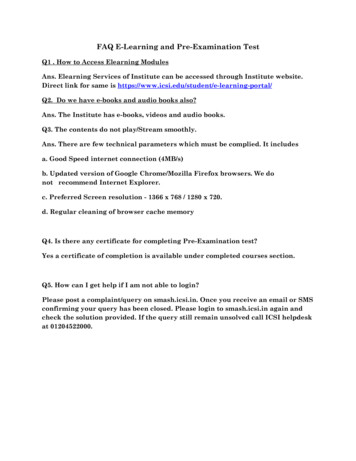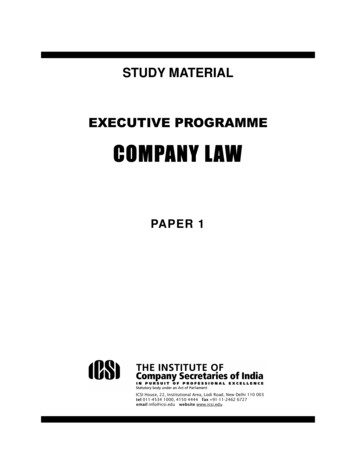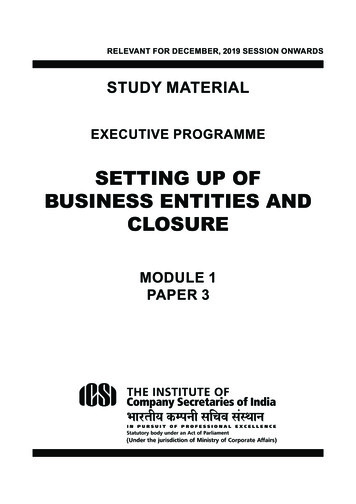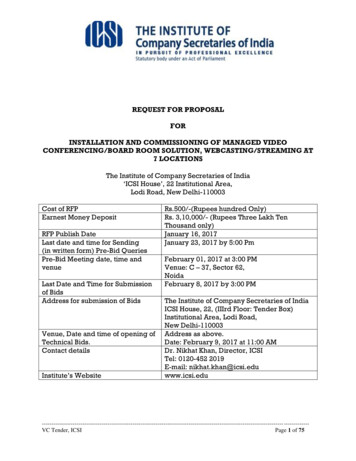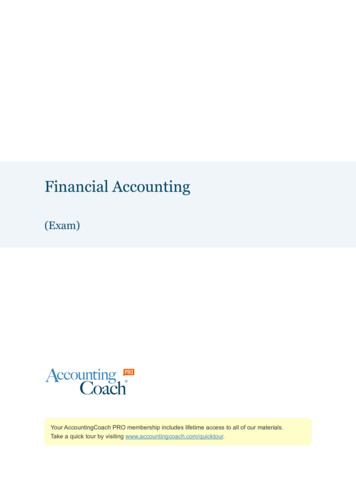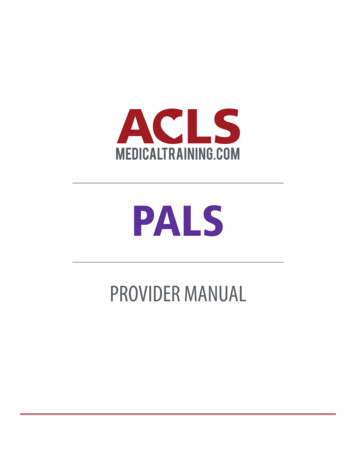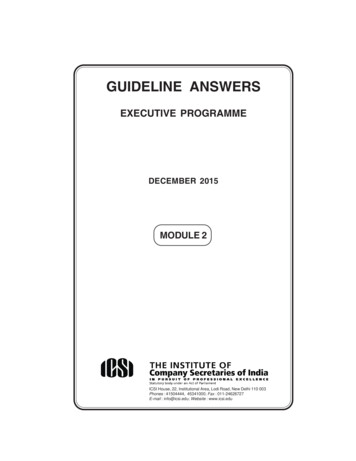
Transcription
GUIDELINE ANSWERSEXECUTIVE PROGRAMMEDECEMBER 2015MODULE 2ICSI House, 22, Institutional Area, Lodi Road, New Delhi 110 003Phones : 41504444, 45341000; Fax : 011-24626727E-mail : info@icsi.edu; Website : www.icsi.edu
These answers have been written by competent personsand the Institute hopes that the GUIDELINE ANSWERS willassist the students in preparing for the Institute'sexaminations. It is, however, to be noted that the answersare to be treated as model answers and not as exhaustiveand the Institute is not in any way responsible for thecorrectness or otherwise of the answers compiled andpublished herein.The Guideline Answers contain the information based on theLaws/Rules applicable at the time of preparation. However,students are expected to be well versed with the amendmentsin the Laws/Rules made upto six months prior to the date ofexamination.C O N T E N T SPageMODULE 21. Company Accounts and Auditing Practices.12. Capital Markets and Securities Laws.233. Industrial, Labour and General Laws(OMR Based Exam.).40
(i)EXECUTIVE PROGRAMMEUPDATING SLIPCOMPANY ACCOUNTS AND AUDITING PRACTICESMODULE – 2 – PAPER 1ExaminationSession(1)All Previous SessionsQuestion No.(2)—Updating required in the answer(3)The Questions and Answers of all previoussessions are to be updated/revised as perthe notified provisions of Companies Act,2013 and the provisions of Companies Act,1956 which is still in force.
(ii)UPDATING SLIPCAPITAL MARKETS AND SECURITIES LAWSMODULE – 2 – PAPER 2ExaminationSession(1)All Previous SessionsQuestion No.(2)—Updating required in the answer(3)All answers are based on the notifiedprovisions of Companies Act, 2013 and theprovisions of Companies Act, 1956 whichare still in force.SEBI (ICDR) Regulations. All answerspertaining to Issue of securities to beupdated according to amended Regulation.
1EP–CAAP–December 2015EXECUTIVE PROGRAMME EXAMINATIONDECEMBER 2015COMPANY ACCOUNTS AND AUDITING PRACTICESTime allowed : 3 hoursMaximum marks : 100NOTE : 1. Answer ALL Questions.2. All working notes should be shown distinctly.PART AQuestion 1(a) A listed company intends to issue sweat equity shares to its directors and aclass of employees. Advise the company about the conditions to be fulfilled forsuch an issue.(b) What are the objectives of sound corporate financial reporting ?(c) Zenith Ltd. has inadequacy or absence of profits in the financial year 2014-15but it wants to declare dividend. What are the conditions to be fulfilled to declaredividend out of free reserves ?(d) Fitness Ltd. is planning to raise funds by making rights issue of equity shares topart finance its expansion. The existing equity share capital of the company is 40 lakh and the market value is 45 per share. The company offered to itsshareholders the right to buy 2 shares at 12 each for every 5 shares held. Youare required to calculate —(i) Theoretical market price per share after the rights issue;(ii) The value of rights; and(iii) Percentage increase in share capital.(e) A company has its share capital divided into shares of 10 each. On 1st April,2014, it granted 5,000 shares as employees stock options at 40 per share,when the market price was 130 per share. The options were to be exercisedbetween 16th December, 2014 and 15th March, 2015. The employees exercisedtheir options for 4,500 shares only; the remaining options lapsed. The companycloses its books on 31st March every year. Show journal entries in the books ofthe company.(5 marks each)Answer 1(a)According to Section 54 of the Companies Act, 2013, a company may issue sweatequity shares of a class of shares already issued, if the following conditions are fulfilled,namely:—(a) The issue is authorised by a special resolution passed by the company;(b) The resolution specifies the number of shares, the current market price,consideration, if any, and the class or classes of directors or employees towhom such equity shares are to be issued;(c) Not less than one year has, at the date of such issue, elapsed since the date onwhich the company had commenced business; and(d) Where the equity shares of the company are listed on a recognised stock1
EP–CAAP–December 20152exchange, the sweat equity shares are issued in accordance with the regulationsmade by the Securities and Exchange Board in this behalf and if they are not solisted, the sweat equity shares are issued in accordance with such rules as maybe prescribed.Answer 1(b)The objectives of corporate financial reporting given by Financial Accounting StandardBoard (FASB) are summarized as follows:1. Financial reporting should provide information that is useful to investors andcreditors and other users in making rational investment, credit and similardecisions. The information should be useful to both, the present and potentialinvestors.2. Financial reporting should provide information about the economic resources ofan enterprise the claims to those resources (obligations of the enterprise totransfer resources to other entities and owners equity) and the effects oftransactions event, and circumstances that change resources and claims tothose resources.3. Financial reporting should provide information about the enterprise’s financialperformance during a period. Investors and creditors often use information aboutthe past to help in assessing the prospects of an enterprise.4. Financial reporting should provide information about how management of anenterprise obtains and spends cash, its borrowing and repayment of borrowing,capital transactions including cash dividends and other distributions of enterpriseresources to owners, and other factors that may affect an enterprise’s liquidityor solvency.5. Financial reporting should provide information about how management of anenterprise has discharged its stewardship responsibilities to owners (shareholders)for the use of enterprise resource entrusted to it.6. Financial reporting should provide information that is useful to management anddirectors in making decisions in the interest of owners.Answer 1(c)Zenith Ltd. will have to fulfil following conditions as per Second Proviso to Section123 (1) of the Companies Act 2013 for payment of dividend:In case of inadequacy or absence of profits in any financial year, any companyproposes to declare dividend out of the accumulated profits earned by it in previous yearsand transferred by the company to the reserves, such declaration of dividend shall not bemade except in accordance with the Companies (Declaration and Payment of Dividend)Rules, 2014. Rule 3 provides that in the event of inadequacy or absence of profits in anyyear, a company may declare dividend out of free reserves subject to the fulfilment of thefollowing conditions, namely: –The rate of dividend declared shall not exceed the average of the rates at whichdividend was declared by it in the three years immediately preceding that year. However,
3EP–CAAP–December 2015this shall not apply to a company, which has not declared any dividend in each of thethree preceding financial year.— The total amount to be drawn from such accumulated profits shall not exceedone-tenth of the sum of its paid-up share capital and free reserves as appearingin the latest audited financial statement.— The amount so drawn shall first be utilised to set off the losses incurred in thefinancial year in which dividend is declared before any dividend in respect ofequity shares is declared.— The balance of reserves after such withdrawal shall not fall below fifteen per centof its paid up share capital as appearing in the latest audited financial statement.Answer 1(d)Rs.Market Value of 5 shares already held by a shareholder @ Rs. 45 each Add : Price to be paid for 2 more shares@ Rs. 12 each225 Total price of 7 shares after rights issue24249(i) Theoretical Market price after the rights issue 249/7 35.57(ii) Value of Rights Market price- Theoretical Market Price 45-35.57 9.43(iii) Percentage increase in share capital:Present capital 40,00,000Rights Issue (40,00,000 2)/5 16,00,000Percentage increase in share capital 16,00,000/40,00,000 x 100 40 %Answer 1(e)Journal EntriesDateParticularsAmount in AmountRs. (Dr.)in Rs.(Cr.)April 01, 2014 Employee Compensation Expenses A/cDr.4,50,000To Employee Stock Options OutstandingA/c4,50,000(Being grant of 5000 stock options toemployees at Rs. 40 when market price isRs. 130)December 16,2014Bank A/c (4,500 x 40)Dr.1,80,000Employee Stock options Outstanding A/c Dr.(4,500 x 90)4,05,000
EP–CAAP–December 20154To Equity share capital A/c (4500 x 10)45,000To Securities premium A/c (4500 x 120)5,40,000(Being allotment to employees of 4500equity shares of Rs. 10 each at a premiumof Rs. 120 per share in exercise of stockoptions by employees)March 16, 2015 Employee stock option outstanding A/ cDr.45,000To Employee Compensation Expenses A/c45,000(Being entry for lapse of stock options for500 shares)March 31, 2015 Profit & loss a/cDr.4,05,000To Employee Compensation expenses A/c4,05,000(Being transfer of employee compensationexpenses to profit and loss account)Attempt all parts of either Q.No. 2 or Q.No. 2AQuestion 2(a) Base Ltd. is not satisfied with its economic value added and wants to improve itfurther. What corrective action should it take to improve the same ? (3 marks)(b) State three salient features of 'pooling of interest' method of amalgamation.(3 marks)(c) When dividend is declared and paid by a subsidiary company out of pre-acquisitionand post-acquisition profits, how will the same be dealt with in the books of aholding company ?(3 marks)(d) When are diluted earnings per share (EPS) calculated ? From the followinginformation, calculate diluted earnings per share (EPS) of the company :Net profit for the current year (after tax) 83,00,000Number of equity shares outstanding20,00,000Number of 10% convertible debentures of 100 each(each debenture is convertible into 10 equity shares)Interest expenses for the current yearTax relating to interest expenses1,00,000 10,00,00030%(3 marks)(e) Explain the method of valuation of equity shares based on price-earnings ratio.(3 marks)
5EP–CAAP–December 2015OR (Alternate question to Q.No. 2)Question 2A(i) Explain with examples 'interest accrued and due' and 'interest accrued but notdue'. How are these items shown in the balance sheet ?(5 marks)(ii) Cheer Ltd. is interested in issuing 10,000, 12% debentures of 100 each. Youare required to pass necessary journal entries in each of the following situations:(a) Issued at 10% discount and redeemable at par(b) Issued at 5% premium and redeemable at par(c) Issued at par and redeemable at premium of 5%(d) Issued at discount of 5% and redeemable at premium of 10%(e) Issued at premium of 10% and redeemable at premium of 20%. (5 marks)(iii) Excel Ltd. issued 1,00,000 equity shares and the entire issue was underwrittenas follows :Underwriter - X — 50%Underwriter - Y — 30%Underwriter - Z — 20%Applications were received for 90,000 shares. Out of these, applications for20,000 shares were marked with X; 10,000 marked with Y and 5,000 markedwith Z. The remaining applications for 55,000 shares did not bear any stamp.Determine the liability of each underwriter in relation to above.(5 marks)Answer 2(a)The following corrective action should be taken by Base Ltd. to improve its economicvalue added:First, operating performance with respect to operating profit margins or asset turnoverratios could be improved to generate more revenue without using more capital.Second, the capital invested in the business might be reduced by selling underutilized assets; this strategy will simultaneously improve operating performance througha higher asset turnover ratio, as well as a reduced capital charge against thoseearnings because of a reduced debt or equity capital investment.Third, redeploy the capital invested to projects and activities that have higher operatingperformance than the current projects or investments are exhibiting.And fourth, if the business is not highly leveraged, change the capital structure bysubstituting lower cost debt for higher cost equity. Although this last strategy willdecrease net income because of the higher interest cost, it will improve the EVA ofthe business because the total cost of debt and equity is reduced, and EVA measuresthe value created after all costs of capital (debt and equity) have been taken intoaccount.
EP–CAAP–December 20156Answer 2(b)The ‘Pooling of Interests’ Method is for an amalgamation in the nature of merger.Following are the three salient features of this method:— The assets, liabilities and reserves of the transferor company are recorded bythe transferee company at their existing carrying amounts and in the same formas at the date of amalgamation.— If, at the time of the amalgamation, the transferor and the transferee companieshave conflicting accounting policies, a uniform set of accounting policies isadopted following the amalgamation.— The difference between the amount recorded as share capital issued (plus anyadditional consideration in the form of cash or other assets) and the amount ofshare capital of the transferor company should be adjusted in the reserves of thetransferee company. Accordingly no goodwill or capital reserve will arise out ofamalgamation by way of merger.Answer 2(c)Dividend received by the holding company out of pre-acquisition profits of the subsidiarycompany are credited to investment in shares of the subsidiary account thereby reducingthe cost of control or increasing capital reserve.Dividend received out of the post-acquisition profits are treated as income and creditedto profit & loss Account by the holding company. If dividend declared partly out of preacquisition profits and partly out of post- acquisition profits, the dividend received isdivided into two parts in proportion to its declaration. The dividend pertaining to the first(i.e. capital profit) is credited to Investment Account and dividend pertaining to secondpart (i.e., revenue profits) is credited to Profit and Loss Account.Answer 2(d)Diluted earnings per share is calculated when there are potential equity shares inthe capital structure of the enterprise. Potential equity share are those financial instrumentswhich entitle the holder to the right of equity shares like convertible debentures, convertiblepreference shares, options warrants etc.Calculation of Diluted earnings per share:Rs.Net profit for the current year83,00,000Add : Interest expense for the current year10,00,000Less: tax relating to Interest expense (30% of Rs. 10,00,000) (3,00,000)Adjusted net profit for the current year90,00,000Number of equity shares resulting from conversion of debentures 1,00,000 x 10 10,00,000 equity shares .Diluted earnings per share 90,00,000/30,00,000 shares Rs. 3 per ShareAnswer 2(e)Valuation based on price earnings ratio method is suitable for ascertaining the marketvalue of shares which are quoted on a recognised stock exchange. According to this
7EP–CAAP–December 2015method, the shares are valued on the basis of earning per share multiplied by priceearning ratio.Thus, Market value of share Price earning ratio x Earning per shareEarning per share Price earning ratio Profit available for equity shareholdersNumber of equity sharesMarket value per shareEarning per shareAnswer 2A(i)Interest accrued and dueInterest on debentures which has become payable but remain unpaid on due date ofpayment is known as interest accrued and due. For example, a company has issued12% Debentures for Rs. 10,00,000 interest is payable on 30th September and 31stMarch. Suppose, the company closes its books on 31st March, the interest due on thatdate may be unpaid. Thus Rs. 60,000 (half year interest) will be recorded as interestaccrued and due. The liability will be shown in the Balance Sheet along with debentures.Interest accrued but not dueInterest on debentures which has accrued but remains unpaid because the due datefor payment of interest has not yet come is known as interest accrued but not due. Forexample, a company has issued 12% Debentures for Rs. 10,00,000 and interest ispayable on 30th June and 31st December. Suppose, the company closes its books on31st March, the interest for the period from 1st January to 31st March has accrued butnot paid because next due date for payment is 30th June. For proper accounting, interestexpense for the full year must be recorded in the books of accounts. Thus, Rs 30,000 willbe recorded as interest accrued but not due. Debenture Interest Accrued but not Due isshown in the balance sheet under Other Current Liabilities.Answer 2A(ii)In the Books of XYZ Ltd.Journal EntriesParticulars(a) Bank A/cDiscount on issue of Debentures A/cTo 12% Debentures A/c(Being the issue of debentures at discountof 10% and redeemable at par)Dr. (Rs.)Dr.9,00,000Dr.1,00,000Cr. (Rs.)10,00,000
EP–CAAP–December 20158(b) Bank A/cDr.10,50,000To 12% Debentures A/c10,00,000To Securities Premium A/c50,000(Being the issue of debenture at premiumof 5% but repayable at par)(c) Bank A/cLoss on issue of Debentures A/cDr.10,00,000Dr.50,000To 12% Debentures A/c10,00,000To Premium on redemption of Debentures A/c50,000(Being the issue of debentures at par butrepayable on premium of 5%)(d) Bank A/cLoss on issue of Debentures A/cDr.9,50,000Dr.1,50,000To 12% Debentures A/c10,00,000To Premium on redemption of Debentures A/c1,00,000(Being the issue of debentures at discountbut repayable on premium of 10%)(e) Bank A/cLoss on issue of DebenturesDr.11,00,000Dr.1,00,000To 12% Debentures A/c10,00,000To Premium on redemption of Debentures A/c2,00,000Being the issue of debentures at premium of10% and redemption at premium of 20%)Answer 2A(iii)Net liability of UnderwritersParticularsX (50%)Y (30%)Z (20%)1,00,00050,00030,00020,000Less: market 00020,00015,000Less: unmarked (5:3:2 0Liability agreedNet liabilityTotal
9EP–CAAP–December 2015Question 3(a) The extracts of balance sheets of H Ltd. and S Ltd. as on 31st March, 2015 aregiven below :I.H Ltd.S Ltd.( )( )EQUITY AND LIABILITIES(1) Shareholders' funds(a) Share capitalEquity shares of 10 0020,000Trade ,20,0002,95,000—8,05,0003,20,000(b) Reserves and surplusSecurities premiumGeneral reserveSurplus(2) Current liabilitiesII. ASSETS(1) Non-current assets(a) Fixed assetsTangible assets(b) Long-term investment(15,000 equity shares in S Ltd.at cost)TOTALH Ltd. acquired shares in S Ltd. on 31st March, 2015.You are required to calculate —(a) Minority interest; and(b) Goodwill/capital reserve.(5 marks)(b) Nice Ltd. proposed to acquire the business of Kajal & Co. It was agreed tovalue goodwill at 3 years purchase of the weighted average profits of the past 4years. Profits and weights are as under :YearProfit ( 80,0004Weight
EP–CAAP–December 201510Following further information is revealed :(i) In the year 2012-13, closing stock was overvalued by 6,000.(ii) On 1st December, 2013, a major part was added to the plant at the cost of 15,000 which was charged to revenue instead of capitalising the same. It wasdecided to charge depreciation at 10% per annum on reducing balance method.(iii) Annual charges of 12,000 should be made towards management charges.Calculate the value of goodwill.(5 marks)(c) Liquidation of Weak Ltd. commenced on 2nd April, 2015. However, certaincreditors failed to receive their dues out of realisation of assets and contributionfrom 'A' list contributories. Details of transfer of shares between 1st March,2014 and before commencement of winding-up are given below :ShareholderNo. of sharestransferredDate of ceasing tobe memberCreditors unpaid ondate of transfer ( 2,000Shares were of 10 each, 8 paid-up. Find out the amount to be realised fromvarious shareholders listed above.(5 marks)Answer 3(a)(i)(ii)Calculation of Minority InterestPaid up value of 5,000 (20,000 – 15,000) equity shares50,000Add : 1/4 share of Rs. 80,000 Pre acquisition profits andreserves of S Ltd.20,000Net amount due to Minority shareholders70,000Goodwill / Capital Reserve calculationIntrinsic value of shares held in S Ltd.Paid up value of 15,000 equity sharesAdd : 3/4 share of Rs. 80,000 pre-acquisitionprofits and reserves of S Ltd.Intrinsic value of 15,000 equity sharesPrice paid for 15,000 equity sharesCost of control or Goodwill (2,95,000 – 2,10,000)Working Notes:Pre-acquisition profits and reserves of S Ltd.(10,000 50,000 20,000) Rs. 80,0001,50,00060,0002,10,0002,95,00085,000
11EP–CAAP–December 2015Answer 3(b)(i)Calculation of Adjusted profitsProfits as givenLess: management expensesLess : overvaluation of closing stockAdd : overvaluation of opening stockAdd : major repairs to be capitalisedLess : Depreciation on capitalexpenditure for 4 months @ ation of Average profitYearAdjusted profitWeightsWeighted -1458,50031,75,5002014-1566,55042,66,200Total profit105,68,200Average profit 5,68,200/10 56,820Goodwill at 3 years purchase of average profit 56,820 x 3 Rs. 1,70,460Answer 3(c)A has ceased to be member for more than a year ago, hence he is not liable (thedate of cease to be a member was 1.03.2014 and liquidation date of Weak Ltd. is02.04.2015).ShareholdersNo. of sharestransferredMaximumliability Rs. 2per shareDivision of liability1/5/14 1/10/14 1/11/14 3,2006,6002,000600429,2423,1111,931
EP–CAAP–December 201512Working Notes:1. Ratio of LiabilityDateCumulative liabilityIncrease in liabilitiesRatio of No. of sharesB C 61/11/149,20060010:61/2/1512,0002,800Only E2. Liability of E has been restricted to Rs. 1200, maximum amount payable by him.Hence amount payable by him on 1-2-14 is restricted to Rs. 42.Question 4(a) The balance sheet of Magna Ltd. as on 31st March, 2015 is given below :I.Equity and liabilities (1) Shareholders' funds(a) Share capitalEquity shares of 100 each50,00,00012% cumulative preference shares of 100 each25,00,000(b) Reserves and surplusSurplus(2,00,000)Preliminary expenses(1,00,000)(2) Non-current liabilities10% debentures of 100 each20,00,000(3) Current liabilities(a) Trade payables(b) Tax provisionTOTAL25,00,00050,0001,17,50,000II. Assets(1) Non-current assets(a) Fixed assets(b) Investments (market value 4,75,000)(2) Current assetsTOTAL62,50,0005,00,00050,00,0001,17,50,000It was decided to reconstruct with the following scheme :(i) All the existing equity shares are reduced to 40 each and preference sharesto 60 each.
13EP–CAAP–December 2015(ii) The debentureholders surrender their existing debentures and exchangethe same with fresh 12% debentures of 70 each.(iii) Creditor Prateek to whom the company owes 10,00,000 decided to reducehis claim by 40%. He is allotted 15,000 equity shares of 40 each in fullsatisfaction of the claim.(iv) Tax liability is settled at 75,000.(v) Fixed assets are written down by 30%.(vi) Current assets are revalued at 22,50,000.(vii) Investments be brought down to its market value.(viii) All fictitious assets be written-off.Pass journal entries in the books of the company and prepare capital reductionaccount.(8 marks)(b) Following is the statement of profit and loss of Target Ltd. for the year ended31st March, 2015 : I. Revenue from operations40,25,360II. Other income— Subsidy received from government2,32,560— Interest on investments15,640— Transfer fees— Profit on sale of machinery72025,000III. Total Revenue (I II)2,73,92042,99,280IV. Expenses— Administrative, selling anddistribution expenses8,22,540— Donation to charitable funds25,500— Directors' fee66,760— Interest on debentures31,240— Compensation for breach of contract 42,530— Managerial remuneration2,85,350— Depreciation on fixed assets5,22,540— Provision for taxation— General reserve— Investment revaluation reserveV. Profit for the period (III – IV)VI. Profit brought forward from the lastyear's statementVII. Profit carried forward (V 014,20,180
EP–CAAP–December 201514Additional information :— Original cost of machinery sold was 55,000. The written down value as onthe date of sale was 30,000.— Depreciation on fixed assets as per Schedule II of the Companies Act,2013 was 4,75,340.You are required to calculate and comment on managerial remuneration in thefollowing cases in accordance with the provisions of the Companies Act, 2013if:(i) there is only one whole-time director;(ii) there are two whole-time directors; and(iii) there are two whole-time directors, a part-time director and a manager.(7 marks)Answer 4(a)In the books of Magna Ltd.Journal EntriesParticularsEquity share capital (Rs. 100) A/cDr. (Rs.)Dr.Cr.(Rs.)50,00,000To Equity share capital (Rs. 40)20,00,000To capital Reduction A/c30,00,000(Being conversion of equity shares of Rs. 100to Rs. 40 each as per scheme of reconstruction)12% Cumulative Preference share capital (Rs. 100)Dr.25,00,000To 12% Cumulative Preference sharecapital A/c (Rs. 60)15,00,000To Capital Reduction10,00,000(Being conversion of 12% cumulative preferenceshares (Rs. 100) to 12% preference shares ofRs. 60 each as per scheme of reconstruction)10 % Debenture A/cDr.To 12% DebentureTo Capital Reduction(Being conversion of 10% Debentures (Rs. 100)to 12% debentures of Rs. 70 each as per the schemeof reconstruction)Sundry creditors A/cDr.20,00,00014,00,0006,00,00010,00,000To Equity share capital A/c6,00,000To Capital Reduction A/c4,00,000(Being one creditor agreed to reduce their claimby 40% and accepted 15,000 equity shares @Rs. 40 each)
15EP–CAAP–December 2015Tax Provision A/cDr.50,000Capital Reduction A/cDr.25,000To Bank A/c (Current assets)75,000(Being settlement of Tax liability)Capital Reduction A/cDr.49,75,000To P&L A/c2,00,000To Preliminary expenses A/c1,00,000To Fixed assets A/c18,75,000To Current assets A/c27,50,000To Investment A/c25,000To Capital Reserve A/c25,000(Being amount of Capital reduction utilised inwriting off fictitious assets and bringing down offixed assets, current assets and Investments andbalance transferred to capital reserve)Capital Reduction A/cParticularsAmount (Rs.) ParticularsTo Bank A/c25,000Amount (Rs.)By equity share capital A/c30,00,000To profit & loss A/c2,00,000By 12% Cum Preference shares A/c 10,00,000To Preliminary Expense A/c1,00,000By 10% Debentures A/c6,00,000To Fixed assets A/c18,75,000By Sundry Creditors A/c4,00,000To Current assets A/c27,50,000To Investment A/c25,000To Capital Reserve A/c25,00050,00,00050,00,000Answer 4(b)Calculation of Net Profit u/s 198 of the Companies Act, 2013ParticularsRs.Balance from trading accountAdd : subsidies received from Govt.Interest on InvestmentTransfer feesProfit on sale of 2042,99,280
EP–CAAP–December 201516Less : Administrative, Selling and Distribution expenses 8,22,540Donation to charitable funds25,500Director’s fees66,760Interest on Debentures31,240Compensation for breach of contract42,530Depreciation on Fixed assets as per Schedule II of theCompanies Act, 20134,75,340Net profit14,63,91028,35,370Calculation of Managerial Remunerationi) When there is only one whole time directorWhen there is only one Whole time director, Managerial remuneration 5% ofRs.28,35,370 Rs. 1,41,768.50ii) When there are two whole-time directors, Managerial remuneration 10% ofRs. 28,35,370 Rs. 2,83,537iii) When there are two whole time directors, a part time director and a manager,Managerial remuneration 11% of Rs. 28,35,370 Rs. 311890.70Since, the managerial remuneration as per profit and loss account is Rs. 2,85,350which exceeds the maximum amount payable in situation (a) and (b) above,therefore the company should obtain the necessary approval.Alternate Answer for calculation of Net Profit u/s 198 of the Companies Act, 2013Net balance (1420180 – 572360)8,47,820Add : Managerial remuneration2,85,350Depreciation on Fixed assets5,22,540Provision for taxationGeneral reserveInvestment Revaluation ss : Depreciation on Fixed assets as perSchedule II of the Companies Act, 2013Net profitNote: calculation of Managerial Remuneration will be the same.4,75,34028,35,370
17EP–CAAP–December 2015PART BQuestion 5(a) What do you mean by 'efficiency audit' ? How does it help the management ofan enterprise ?(b) Distinguish between 'internal control' and 'internal audit'.(c) An auditor appointed under Rule 3 of the Companies (Audit and Auditors) Rules,2014 is required to submit a certificate and notice to the Registrar of Companies.State the matters to be covered in the certificate and name of the form of thenotice required to be submitted.(5 marks each)Answer 5(a)Efficiency audit refers to comparing the actual results with the desired/projectedresults. It is directed towards the measurement of whether plans have been effectivelyexecuted. It is concerned with the utilisation of the resources in economic and mostremunerative manner to achieve the objectives of the concern. It comprises of studyingthe plans of organisation, comparing actual performance with plans and investigating thereasons for variances to take remedial action. More specifically, such audits can:— help managers and staff to be more sensitive to their obligation of due regard toefficiency;— underline the importance of measuring efficiency and of using that informationfor managing operations and providing accountability;—
Phones: 41504444, 45341000; Fax: 011-24626727 E-mail: info@icsi.edu; Website: www.icsi.edu. These answers have been written by competent persons and the Institute hopes that the GUIDELINE ANSWERS will assist the students in preparing for the Institute's . enterprise obtains and spends cash, its borrowing and repayment of borrowing, .


